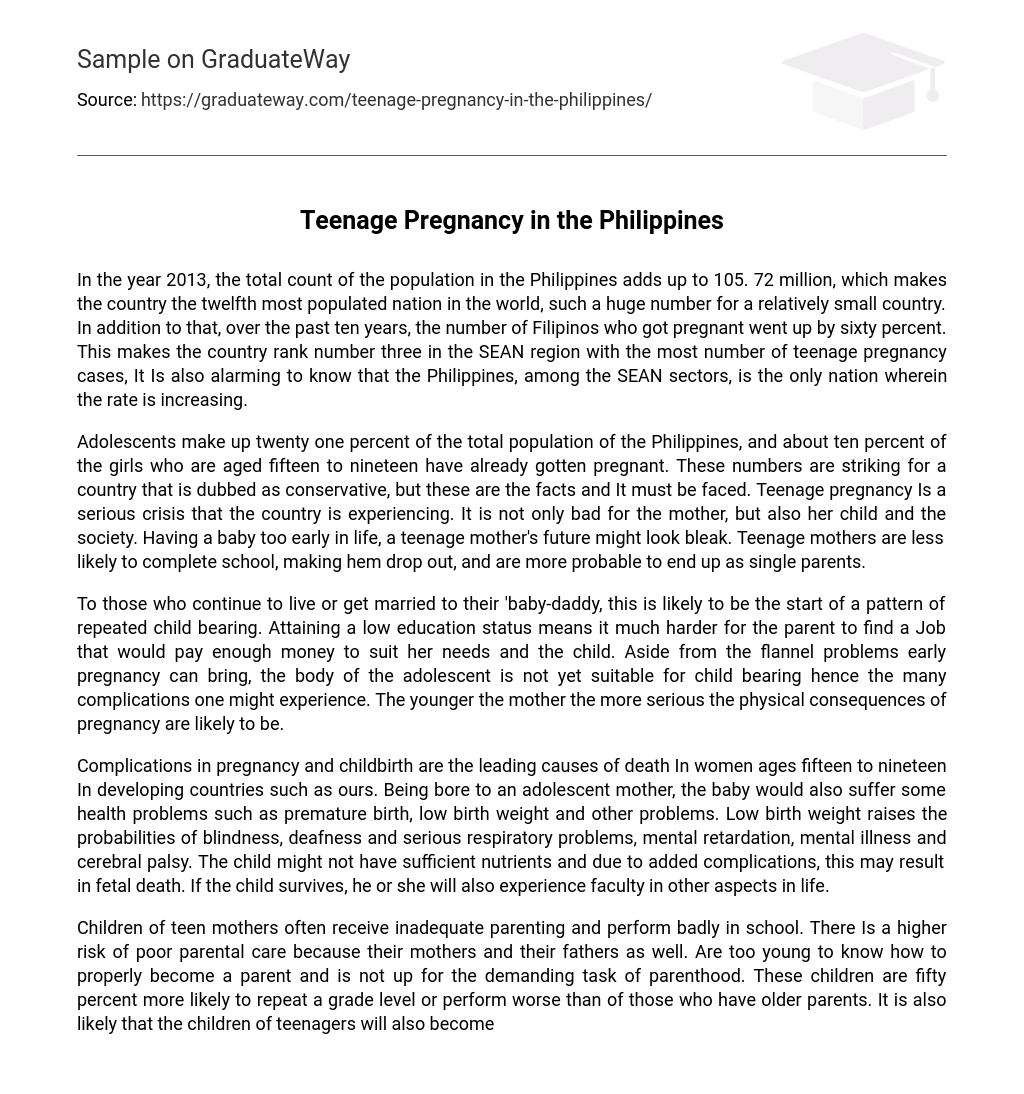In the year 2013, the total count of the population in the Philippines adds up to 105. 72 million, which makes the country the twelfth most populated nation in the world, such a huge number for a relatively small country. In addition to that, over the past ten years, the number of Filipinos who got pregnant went up by sixty percent. This makes the country rank number three in the SEAN region with the most number of teenage pregnancy cases, It Is also alarming to know that the Philippines, among the SEAN sectors, is the only nation wherein the rate is increasing.
Adolescents make up twenty one percent of the total population of the Philippines, and about ten percent of the girls who are aged fifteen to nineteen have already gotten pregnant. These numbers are striking for a country that is dubbed as conservative, but these are the facts and It must be faced. Teenage pregnancy Is a serious crisis that the country is experiencing. It is not only bad for the mother, but also her child and the society. Having a baby too early in life, a teenage mother’s future might look bleak. Teenage mothers are less likely to complete school, making hem drop out, and are more probable to end up as single parents.
To those who continue to live or get married to their ‘baby-daddy, this is likely to be the start of a pattern of repeated child bearing. Attaining a low education status means it much harder for the parent to find a Job that would pay enough money to suit her needs and the child. Aside from the flannel problems early pregnancy can bring, the body of the adolescent is not yet suitable for child bearing hence the many complications one might experience. The younger the mother the more serious the physical consequences of pregnancy are likely to be.
Complications in pregnancy and childbirth are the leading causes of death In women ages fifteen to nineteen In developing countries such as ours. Being bore to an adolescent mother, the baby would also suffer some health problems such as premature birth, low birth weight and other problems. Low birth weight raises the probabilities of blindness, deafness and serious respiratory problems, mental retardation, mental illness and cerebral palsy. The child might not have sufficient nutrients and due to added complications, this may result in fetal death. If the child survives, he or she will also experience faculty in other aspects in life.
Children of teen mothers often receive inadequate parenting and perform badly in school. There Is a higher risk of poor parental care because their mothers and their fathers as well. Are too young to know how to properly become a parent and is not up for the demanding task of parenthood. These children are fifty percent more likely to repeat a grade level or perform worse than of those who have older parents. It is also likely that the children of teenagers will also become teen parents themselves when they grow up, setting their parents as mere examples. It is a ruthless cycle.
Teenage pregnancy costs the country billions of pesos for the reason that teenage mothers rely on welfare and the government helps hundreds of families who began with teenage pregnancy. These parents depend on the help their country gives and their country cannot neglect these people, with this being said, Instead of allocating more money for other Issues concerning the nation, the government allots a percentage of the national budget to 1 OFF tans sector. I Nils year, 2014, ten government allotted Y Welfare services alone. Teenage pregnancy is not only costing the country but the lives of these young parents as well.
Schools play an important role in the life of every child. Every year, millions of children go to school and get educated. A study shows that “by promoting educational success, developing skills that build a positive future and helping young people to feel a strong sense of purpose, schools can help strengthen young people’s motivation to delay pregnancy and parenthood”. Adolescents who have greater motivation to obtain an education and better access to educational opportunities are also motivated to delay sexual activity and childbearing. Education must be taken advantage of since every child in the
Philippines is supposed to be put in school; it is a law. Aside from encouraging children to do better in school and have higher goals in life, by using education, children (teenagers) would be more aware of the consequences of early child bearing. Clearly, schools in the Philippines are doing that but the so called ‘sex education’ the country has now is not providing what is needed. To lessen the teenage pregnancy incidences in the Philippines, learning institutions should implement a subject wherein its main focus is to teach adolescent education, in order to improve the country’s current state concerning teenage pregnancy.





